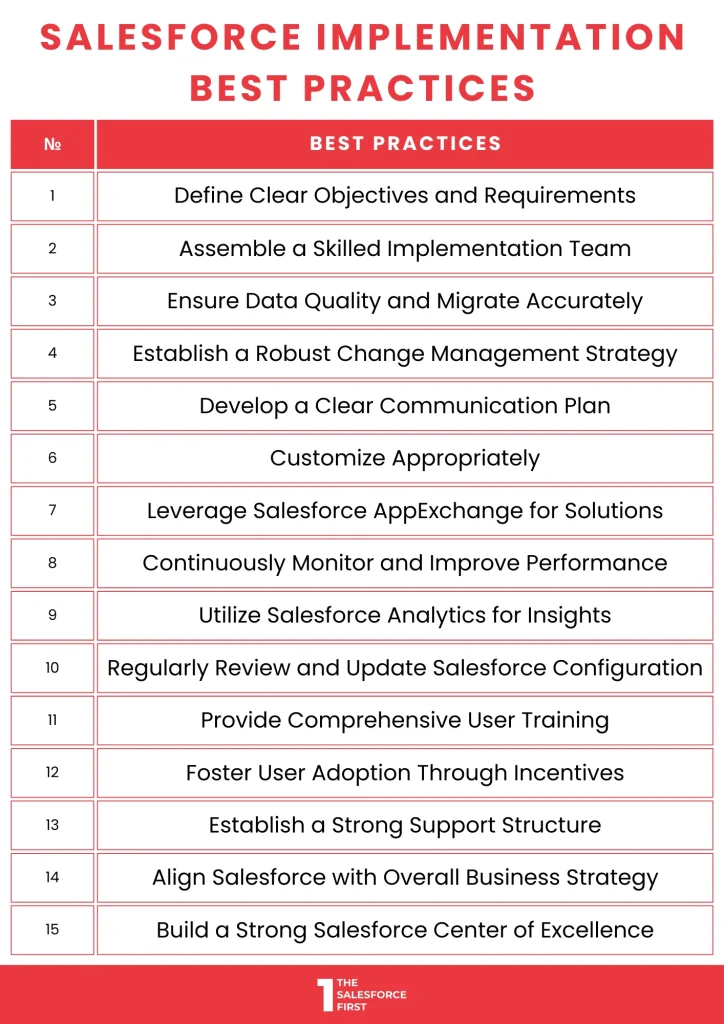A successful Salesforce implementation is pivotal for businesses seeking to optimize operations, enhance customer relationships, and drive growth. By adhering to robust Salesforce implementation best practices, organizations can maximize the platform’s potential and achieve tangible results.
This guide delves into critical areas that encompass the entire implementation lifecycle, from laying a solid foundation to fostering user adoption and establishing a centre of excellence.
By following these Salesforce implementation best practices, organizations can ensure a smooth implementation, optimize Salesforce’s capabilities, and ultimately achieve their business objectives.
Table of Contents
Top 15 Salesforce Implementation Best Practices

Phase 1- Foundation and Planning
A solid foundation is paramount for a successful Salesforce implementation. This initial phase sets the tone for the entire project, influencing its efficiency, effectiveness, and overall return on investment. By investing time and resources in meticulous planning and preparation, organizations can mitigate risks, optimize resource allocation, and ensure that the Salesforce platform aligns seamlessly with their business objectives.
A well-defined project scope, clear goals, and a comprehensive implementation roadmap provide a clear direction for the project, minimizing deviations and ensuring that the final solution meets the organization’s specific needs. Effective stakeholder engagement and a robust change management strategy foster collaboration, build buy-in and prepare the organization for the upcoming transformation.
1. Define Clear Objectives and Requirements
A clear understanding of business goals and requirements is essential for aligning Salesforce with organizational needs.
- Conduct in-depth business process analysis to identify pain points and opportunities.
- Involve key stakeholders in defining project objectives and success metrics.
- Create detailed functional and technical requirements.
- Prioritize requirements based on business impact and feasibility.
2. Assemble a Skilled Implementation Team
A competent team with diverse expertise is crucial for project success.
- Identify key roles and responsibilities within the implementation team.
- Assemble a team with a mix of business and technical skills.
- Consider leveraging external implementation consultants or Salesforce partners for specialized expertise.
- Foster collaboration and effective communication among team members.
3. Ensure Data Quality and Migrate Accurately
Accurate and clean data is the foundation for effective Salesforce utilization.
- Conduct a thorough data assessment to identify quality issues.
- Develop a data cleansing and enrichment strategy.
- Test data migration processes to ensure data integrity.
- Establish data governance policies and procedures.
4. Establish a Robust Change Management Strategy
Managing organizational change is essential for successful Salesforce adoption.
- Assess the impact of Salesforce implementation on roles, processes, and systems.
- Develop a communication plan to keep stakeholders informed.
- Provide training and support to end-users.
- Establish a change management team to oversee the process.
5. Develop a Clear Communication Plan
Effective communication is key to stakeholder engagement and project success.
- Identify key stakeholders and communication channels.
- Develop a communication plan outlining key messages and timelines.
- Provide regular project updates and status reports.
- Encourage open communication and feedback.
Phase 2- Customization and Optimization
Tailoring Salesforce to align precisely with an organization’s unique business processes and workflows is crucial for maximizing its value. Effective customization enhances user adoption, improves efficiency, and drives better decision-making. By leveraging Salesforce’s flexibility and the power of the AppExchange, organizations can create a platform that is truly optimized for their specific needs.
Continuous monitoring and optimization are essential to ensure that Salesforce remains aligned with evolving business requirements and delivers optimal performance. By tracking key metrics and making data-driven adjustments, organizations can maximize their investment in the platform.
6. Customize Appropriately
Customization ensures Salesforce meets specific business needs and improves user experience.
- Identify areas where Salesforce’s standard features can be enhanced or extended.
- Prioritize customization based on business impact and complexity.
- Leverage configuration over custom development whenever possible.
- Thoroughly test customizations to prevent issues.
7. Leverage Salesforce AppExchange for Solutions
AppExchange offers pre-built solutions to accelerate implementation and enhance functionality.
- Evaluate AppExchange offerings based on business requirements and compatibility.
- Consider the cost, security, and support implications of AppExchange apps.
- Implement a rigorous evaluation process for selecting AppExchange solutions.
8. Continuously Monitor and Improve Performance
Optimal Salesforce performance is essential for user satisfaction and productivity.
- Implement performance monitoring tools to track system performance.
- Identify performance bottlenecks and optimize accordingly.
- Regularly review and adjust system settings and configurations.
- Consider Salesforce’s performance optimization recommendations.
9. Utilize Salesforce Analytics for Insights
Data-driven insights help organizations make informed decisions and improve performance.
- Identify key performance indicators (KPIs) to measure success.
- Create custom reports and dashboards to visualize data.
- Leverage predictive analytics to identify trends and opportunities.
- Integrate Salesforce analytics with other data sources for a comprehensive view.
10. Regularly Review and Update Salesforce Configuration
Adapting Salesforce to changing business needs is crucial for long-term success.
- Conduct regular Salesforce health checks and audits.
- Identify areas for improvement and optimization.
- Update Salesforce configurations to reflect changes in business processes.
- Stay informed about Salesforce releases and new features.
Phase3: User Adoption and Support
Successful Salesforce implementation hinges on user adoption. When employees embrace the platform and leverage its capabilities, organizations can maximize its benefits, improve productivity, and drive business growth. A strong support structure is essential for addressing user challenges, ensuring optimal performance, and fostering a positive user experience.
11. Provide Comprehensive User Training
Effective training empowers users to utilize Salesforce efficiently and confidently.
- Develop a tailored training curriculum based on user roles and responsibilities.
- Offer a variety of training formats (classroom, online, self-paced) to accommodate different learning styles.
- Provide ongoing training and support to address evolving needs.
- Encourage knowledge sharing among users.
12. Foster User Adoption Through Incentives
Incentives can motivate users to adopt Salesforce and drive behavioural change.
- Offer rewards or recognition for Salesforce proficiency.
- Create friendly competition among users to encourage adoption.
- Highlight the benefits of Salesforce usage to demonstrate its value.
- Celebrate user successes and achievements.
13. Establish a Strong Support Structure
A robust support system ensures users have timely assistance and resolves issues promptly.
- Create a dedicated Salesforce support team or assign support responsibilities.
- Develop knowledge bases and FAQs to address common questions.
- Offer multiple support channels (email, phone, online chat) for user convenience.
- Measure support performance to identify improvement areas.
14. Align Salesforce with Overall Business Strategy
Integrating Salesforce with the broader business strategy maximizes its impact.
- Identify how Salesforce supports organizational goals and objectives.
- Integrate Salesforce with other critical business systems.
- Measure Salesforce’s contribution to business outcomes.
- Continuously evaluate Salesforce’s alignment with the evolving business strategy.
15. Build a Strong Salesforce Center of Excellence
A dedicated centre of excellence ensures ongoing Salesforce success.
- Establish a team of Salesforce experts to provide leadership and guidance.
- Develop Salesforce standards and best practices.
- Foster a community of Salesforce users and enthusiasts.
- Continuously evaluate and improve Salesforce processes and procedures.

End Note
Implementing Salesforce effectively requires a strategic approach that encompasses planning, customization, user adoption, and ongoing optimization. By adhering to the Salesforce implementation best practices outlined in this guide, organizations can build a strong foundation, optimize Salesforce’s capabilities, and foster a culture of user adoption.
Remember, a successful Salesforce implementation is an ongoing journey that requires continuous monitoring, adaptation, and improvement. By prioritizing these Salesforce implementation best practices, organizations can unlock the full potential of Salesforce and drive sustainable business growth.
To accelerate your Salesforce implementation and achieve optimal results, partner with a seasoned Salesforce implementation consultant.


